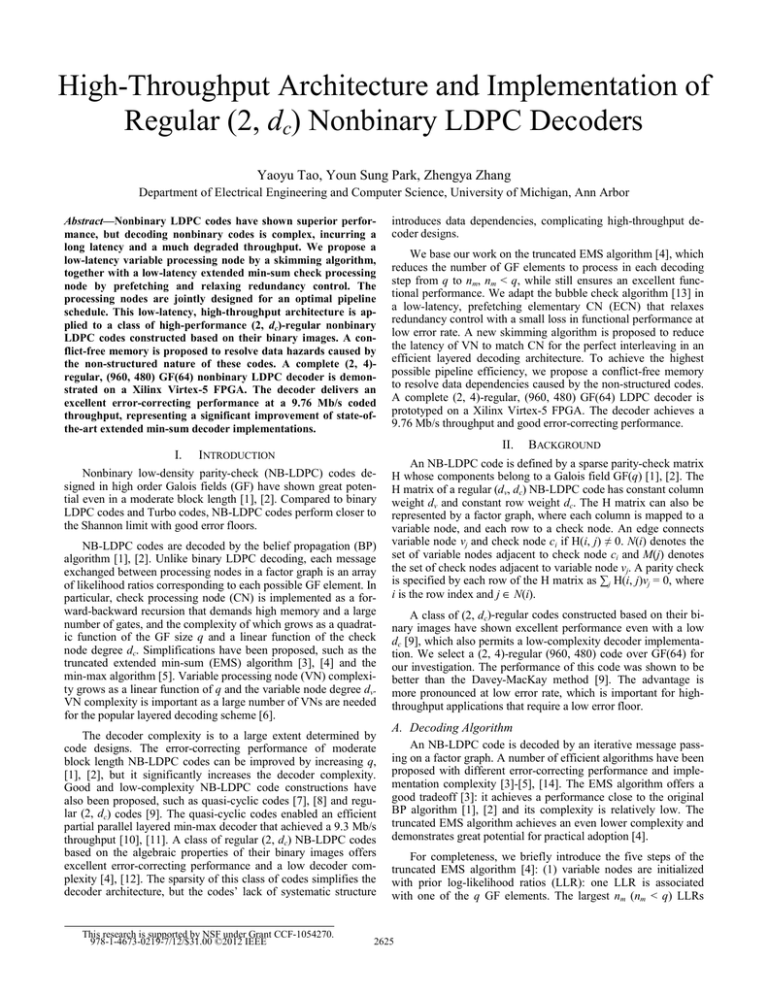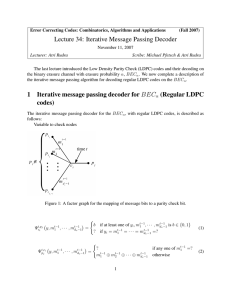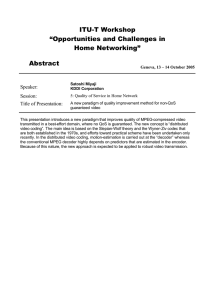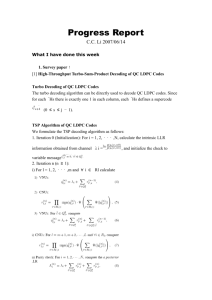High-Throughput Architecture and Implementation of Regular (2, dc
advertisement

High-Throughput Architecture and Implementation of
Regular (2, dc) Nonbinary LDPC Decoders
Yaoyu Tao, Youn Sung Park, Zhengya Zhang
Department of Electrical Engineering and Computer Science, University of Michigan, Ann Arbor
Abstract—Nonbinary LDPC codes have shown superior performance, but decoding nonbinary codes is complex, incurring a
long latency and a much degraded throughput. We propose a
low-latency variable processing node by a skimming algorithm,
together with a low-latency extended min-sum check processing
node by prefetching and relaxing redundancy control. The
processing nodes are jointly designed for an optimal pipeline
schedule. This low-latency, high-throughput architecture is applied to a class of high-performance (2, dc)-regular nonbinary
LDPC codes constructed based on their binary images. A conflict-free memory is proposed to resolve data hazards caused by
the non-structured nature of these codes. A complete (2, 4)regular, (960, 480) GF(64) nonbinary LDPC decoder is demonstrated on a Xilinx Virtex-5 FPGA. The decoder delivers an
excellent error-correcting performance at a 9.76 Mb/s coded
throughput, representing a significant improvement of state-ofthe-art extended min-sum decoder implementations.
I. INTRODUCTION
Nonbinary low-density parity-check (NB-LDPC) codes designed in high order Galois fields (GF) have shown great potential even in a moderate block length [1], [2]. Compared to binary
LDPC codes and Turbo codes, NB-LDPC codes perform closer to
the Shannon limit with good error floors.
NB-LDPC codes are decoded by the belief propagation (BP)
algorithm [1], [2]. Unlike binary LDPC decoding, each message
exchanged between processing nodes in a factor graph is an array
of likelihood ratios corresponding to each possible GF element. In
particular, check processing node (CN) is implemented as a forward-backward recursion that demands high memory and a large
number of gates, and the complexity of which grows as a quadratic function of the GF size q and a linear function of the check
node degree dc. Simplifications have been proposed, such as the
truncated extended min-sum (EMS) algorithm [3], [4] and the
min-max algorithm [5]. Variable processing node (VN) complexity grows as a linear function of q and the variable node degree dv.
VN complexity is important as a large number of VNs are needed
for the popular layered decoding scheme [6].
The decoder complexity is to a large extent determined by
code designs. The error-correcting performance of moderate
block length NB-LDPC codes can be improved by increasing q,
[1], [2], but it significantly increases the decoder complexity.
Good and low-complexity NB-LDPC code constructions have
also been proposed, such as quasi-cyclic codes [7], [8] and regular (2, dc) codes [9]. The quasi-cyclic codes enabled an efficient
partial parallel layered min-max decoder that achieved a 9.3 Mb/s
throughput [10], [11]. A class of regular (2, dc) NB-LDPC codes
based on the algebraic properties of their binary images offers
excellent error-correcting performance and a low decoder complexity [4], [12]. The sparsity of this class of codes simplifies the
decoder architecture, but the codes’ lack of systematic structure
This research is supported by NSF under Grant CCF-1054270.
978-1-4673-0219-7/12/$31.00 ©2012 IEEE
introduces data dependencies, complicating high-throughput decoder designs.
We base our work on the truncated EMS algorithm [4], which
reduces the number of GF elements to process in each decoding
step from q to nm, nm < q, while still ensures an excellent functional performance. We adapt the bubble check algorithm [13] in
a low-latency, prefetching elementary CN (ECN) that relaxes
redundancy control with a small loss in functional performance at
low error rate. A new skimming algorithm is proposed to reduce
the latency of VN to match CN for the perfect interleaving in an
efficient layered decoding architecture. To achieve the highest
possible pipeline efficiency, we propose a conflict-free memory
to resolve data dependencies caused by the non-structured codes.
A complete (2, 4)-regular, (960, 480) GF(64) LDPC decoder is
prototyped on a Xilinx Virtex-5 FPGA. The decoder achieves a
9.76 Mb/s throughput and good error-correcting performance.
II. BACKGROUND
An NB-LDPC code is defined by a sparse parity-check matrix
H whose components belong to a Galois field GF(q) [1], [2]. The
H matrix of a regular (dv, dc) NB-LDPC code has constant column
weight dv and constant row weight dc. The H matrix can also be
represented by a factor graph, where each column is mapped to a
variable node, and each row to a check node. An edge connects
variable node vj and check node ci if H(i, j) ≠ 0. N(i) denotes the
set of variable nodes adjacent to check node ci and M(j) denotes
the set of check nodes adjacent to variable node vj. A parity check
is specified by each row of the H matrix as ∑j H(i, j)vj = 0, where
i is the row index and j ∈ N(i).
A class of (2, dc)-regular codes constructed based on their binary images have shown excellent performance even with a low
dc [9], which also permits a low-complexity decoder implementation. We select a (2, 4)-regular (960, 480) code over GF(64) for
our investigation. The performance of this code was shown to be
better than the Davey-MacKay method [9]. The advantage is
more pronounced at low error rate, which is important for highthroughput applications that require a low error floor.
A. Decoding Algorithm
An NB-LDPC code is decoded by an iterative message passing on a factor graph. A number of efficient algorithms have been
proposed with different error-correcting performance and implementation complexity [3]-[5], [14]. The EMS algorithm offers a
good tradeoff [3]: it achieves a performance close to the original
BP algorithm [1], [2] and its complexity is relatively low. The
truncated EMS algorithm achieves an even lower complexity and
demonstrates great potential for practical adoption [4].
For completeness, we briefly introduce the five steps of the
truncated EMS algorithm [4]: (1) variable nodes are initialized
with prior log-likelihood ratios (LLR): one LLR is associated
with one of the q GF elements. The largest nm (nm < q) LLRs
2625
The decoding latency and throughput can be further degraded
due to the structure of the (2, dc)-regular codes. Pipeline stalls
need to be inserted to resolve data dependencies. The challenges
with the decoder architecture call for new processing node designs and efficient memory access schemes.
III. DESIGN FOR LOW LATENCY AND HIGH THROUGHPUT
We introduce improvements in both CN and VN operations in
order to enable a pipeline with lower latency and higher throughput.
Fig. 1. Layered architecture of a (2, 4)-regular NB-LDPC code.
A. Low-Latency ECN and Improved Pipeline Schedule
ECN is the elementary building block of CN, and it is used
for forward, backward, or merging operation. ECN takes two
LLR vectors U and I along with the corresponding GF indices βU
and βI to produce V and βV using the max-log algorithm [4]: V[i]
= maxS(βV[i]) (U[j] + I[p]), i, j, p ∈ {0, …, nm – 1} and S(βV[i]) is
the set of all combinations of βV[i], βU[j], and βI[p] that satisfy
βV[i] + βU[j] + βI[p] = 0 over GF(q).
Fig. 2. Scheduling of the (2, 4) layered decoder architecture.
along with the corresponding GF element (or index) are stored in
vector L and βL respectively in descending order; (2) variable-tocheck (v-c) messages are permuted based on the H matrix and
sent to the check nodes. In the first iteration, the priors are used as
the v-c messages; (3) for each adjacent variable node vj, check
node ci computes the check-to-variable (c-v) message {Vij[k]}, k
∈ {0, …, nm – 1}, that the parity-check equation is satisfied if vj =
βVij[k] (where βVij[k] is a vector containing GF elements or indices). The computation is done using a forward-backward recursion. Note that only the nm highest probabilities are computed and
stored; (4) the c-v messages are inverse permuted before being
sent to the variable nodes; (5) each variable node vj is updated
with messages from the adjacent check nodes. A v-c message
{Uji[k]}, k ∈ {0, …, nm – 1}, is computed for each adjacent check
node ci, based on the prior L and all received c-v messages except
from check node ci. The procedure repeats itself from step (2).
B. Decoder Architecture and Challenges
A high-level block diagram of a row-layered NB-LDPC decoder architecture is shown in Fig. 1 for the selected (2, 4)-regular
code. The architecture consists of 4 VNs and 1 CN. The
processing schedule for this architecture is shown in Fig. 2. CN
reads v-c messages and performs forward-backward recursion on
a 4-stage trellis in three steps: (1) 1 forward step, (2) 1 backward
step, and (3) 4 merging steps. Forward and backward steps can be
overlapped, and 4 merging steps can be overlapped too. Each step
in the recursion is done by an elementary CN (ECN). ECN carries
out the max-log computation and sorts the results. The sorter
length is nm and latency of each ECN operation is at least 2nm
clock cycles. The bubble check algorithm [13] reduces the sorter
length to approximately ඥ݊ .
After the CN operation is complete and c-v messages have
been written to memory, VN operation is started. A v-c message
is calculated by adding the c-v message and the prior. Note that
the addition requires the matching of GF indices, where a contentaddressable memory is required. The results also need to be
sorted, with a latency of at least 2nm cycles. Altogether the
processing of one row of the H matrix takes 4nm cycles. With 80
rows in the selected code and nm = 16, one decoding iteration
takes at least 5,120 cycles.
The proposed low-latency ECN is based on the bubble check
algorithm [13]. We improve upon the original algorithm by prefetching and relaxing redundancy control (i.e., allowing duplicate
GF entries), which together shorten the latency of an ECN operation from at least 2nm to nm + LS-ECN + 2 clock cycles, where LS-ECN
is the sorter length used in ECN and LS-ECN < nm [13]. Simulation
shows that relaxing redundancy control introduces functional
performance loss at high error rate, but the loss becomes negligible at low error rate that is of more practical interest. The proposed ECN is described below, assuming both U and I are sorted
in descending order:
(1) Initialization: insert U[j] + I[0], where j = 0, …, LS-ECN – 1, sequentially to the sorter in descending order.
(2) Set jcurr = 0 and pcurr = 1.
(3) Fetch U[jcurr] and I[pcurr]. Compute Sin = U[jcurr] + I[pcurr]. Insert
Sin. If the sorter is full, output the maximum value in the sorter Smax
before inserting Sin.
(4) Find the next pair of indices jnext and pnext. (Define a direction flag
R, with R = 1 initially. The second largest value in the sorter is denoted Smax,2, which is the sum of U[jmax,2] and I[pmax,2].)
(a) If (Smax,2 < Sin), then j = jcurr and p = pcurr,
else j = jmax,2 and p = pmax,2
(b) if (j = 0), then R = 1,
else if (p = 0 and j ≥ LS-ECN – 1), R = 0.
(c) Set jnext = j + !R and pnext = p + R (! denotes inversion).
(5) Set jcurr = jnext and pcurr = pnext.
(6) Go back to (3) until all nm values have been output from the sorter.
The main difference between the proposed algorithm and the
original bubble check algorithm is the use of Smax,2 and Sin to decide one cycle ahead the next inputs to the sorter. The prefetching
shortens the latency because both sorting and reading can execute
concurrently without waiting. The algorithm stops after nm outputs, and redundancy (duplicate GF entries) in the output is permitted. The high-level architecture of the ECN is shown in Fig. 3.
The length of the sorter LS-ECN is determined by nm. For the
case of nm = 16, the maximum number of pending candidates will
be 6 and therefore LS-ECN = 6 is the best choice [13]. The latency
of the first ECN output is LS-ECN + 2 = 8 cycles, which enables
early starts on subsequent ECN or VN operations. In total, one
complete ECN operation takes 24 cycles to produce 16 outputs.
2626
The proposed ECN allows the pipeline latency of CN to be
shortened and throughput improved. Fig. 4 shows the updated
pipeline schedule, where the 4 parallel merge steps start when the
first output from the forward and backward steps are ready. With
a short 8-cycle latency, the merge steps are effectively overlapped
with the forward and backward steps. Furthermore, using two sets
of memories in CN RAM for alternating rows, the forward and
backward step of the next row can start right after the current row
is complete, hence making full utilization of the hardware. The
improved pipeline schedule enables a complete CN processing in
every 24 cycles.
B. Low-Latency VN
In order to fully take advantage of the latency reduction of the
CN and the updated pipeline schedule, the VN operation also
needs to be improved to avoid becoming the bottleneck. The four
outputs produced by the CN need to be processed in parallel by
VNs within 24 cycles, or else it will stop the pipeline.
Cy
cl
e9
6
Cy
cl
e8
8
72
C
yc
le
56
Cy
cl
e6
4
C
yc
le
Cy
cl
e4
8
Cy
cl
e4
0
24
yc
le
Cy
cle
32
C
C
yc
le
16
Cy
cl
e0
Fig. 3 ECN architecture.
A VN takes two LLR vectors V (c-v message) and L (prior likelihoods) along with their GF indices βV and βL to produce a
new U (v-c message) and its GF index βU [5]. Since nm < q, the
VN operation needs to scan both the V vector and L vector for
matching entries with a latency of at least 2nm.
We propose a simplified VN algorithm to achieve a lowlatency by skimming the prior messages, i.e., allocate only LS-VN
cycles to scan the L vector, where LS-VN is the sorter length used in
VN and LS-VN < nm. Due to limited space, we will simply introduce
the algorithm and defer the full discussion to a follow-up publication. The algorithm is divided into two stages, assuming both L
and V are sorted in descending order:
Fig. 4. Overlapped pipeline schedule.
(1) Scan the top LS-VN entries in βL sequentially: search βL[l], l ∈ {0,
…, LS-VN – 1}, in βV for matching entries. Compute Sin = L[l] + V[i],
if βL[l] = βV[i]; or Sin = L[l] + YV, if no matching entry is found,
where YV is a compensation constant based on V[nm - 1]. Insert Sin to
the sorter.
(2) Scan the nm entries in V sequentially. Compute Sin = V[i] + YL,
where YL is a compensation constant based on L[nm - 1]. Insert Sin to
the sorter. The maximum entry in the sorter is output every time a
new Sin is inserted to the sorter.
The architecture of the proposed VN is shown in Fig. 5. A content-addressable memory is used to search matching entries. If we
choose LS-VN = 6, a complete VN operation takes 24 cycles to
produce 16 outputs for the perfect interleaving with CN as shown
in Fig. 4. Note that since LS-VN < nm, some low order entries in
vector L will be missed, which degrades the functional performance by 0.65 dB at FER of 10-5 as shown in Fig. 6. To compensate the performance loss, we can increase LS-VN and use two sets
of VNs to accommodate a higher processing latency without
stopping the pipeline. In this way, while the first set is working on
one row, the second set starts to process the second row immediately when the inputs are available. Alternatively, a short pipeline stall can be inserted. Simulation results in Fig. 6 show that a
small increase to LS-VN = 10 eliminates the performance loss.
IV. MEMORY CONFLICT RESOLUTION
Unlike quasi-cyclic codes, the (2, dc)-regular NB-LDPC code
lacks a systematic structure. When multiple VNs operate in parallel, both intra- and inter-iteration memory access conflicts arise,
causing pipeline stalls. In particular, CN reads 4 v-c messages at
the same time, requiring them to be stored in 4 sets of memory.
CN then passes the c-v messages to 4 VNs that will write their v-
Fig. 5. VN architecture.
c messages to a centralized memory to be read by later CN
processing. However, as illustrated in Fig. 7, writing to the v-c
memory can be problematic because conflicts can occur when
two or more VNs write to the same memory set. The worst-case
conflict occurs when all 4 VNs are attempting to write to one set.
Our solution is to subdivide each set into smaller subsets determined by the code structure. The conflicting v-c messages would
be written to different subsets within the same set. Note that this
solution would require a separate look-up table in each set to select the correct subset for each read and write access, but the size
of the v-c memory will remain the same.
Read-after-write (RAW) hazards can also occur due to data
dependencies across consecutive iterations. For instance, if the
VN that writes back to the first row shown in Fig. 7 does not
finish in time (e.g., v0→c0), the next iteration would read the old
values. We resolve this inter-iteration data dependency by shuffling the rows in the H matrix such that the last row does not produce any output that is needed by the first row. The conflict-free
scheme ensures a stall-free pipeline for a high throughput.
2627
TABLE I FPGA MAPPING RESULTS
(BASED ON XILINX VIRTEX-5 XC5VLX155T)
Resource
Slice
Registers
Slice
LUTs
Occupied
Slices
BRAMs
1× parallel
(single-set VN,
LS-VN = 6)
1× parallel
(dual-set VN,
LS-VN = 16)
4× parallel
(single-set VN,
LS-VN = 6)
12,444 (13%)
16,533 (17%)
49,847 (54%)
15,099 (15%)
19,505 (20%)
64,423 (64%)
5,954 (24%)
8,128 (33%)
23,839 (97%)
49 (23%)
82 (39%)
197 (93%)
V.
FPGA PROTOYPING
The proposed decoder architecture has been prototyped for a
(2, 4)-regular (960, 480) NB-LDPC code over GF(64) on a Xilinx
Virtex-5 FPGA. Table I shows the hardware utilization of the two
approaches proposed in Section III: one is based on LS-VN = 6 using one set of 4 VNs, and the other based on LS-VN = 16 using 8
VNs grouped in two sets. The latter costs more hardware resources and but produces better functional performance. An 8-bit
fixed-point quantization has been used in all the implementations.
Fig. 6. Performances of a (2, 4)-regular, (960, 480) NB-LDPC
over GF(64).
The FPGA decoders operate at a clock frequency of 100 MHz
for a coded throughput of 2.44 Mb/s with 10 decoding iterations.
We were able to map a 4× parallel decoder based on the proposed
architecture on this FPGA device for a throughput of 9.76 Mb/s.
The result represents a significant improvement over the state-ofthe-art EMS decoder implementations [4], [12], [15]. By layered
decoding, the convergence speed is improved and simulations
show that the average number of iterations is reduced from 2.39
to 1.77 at FER = 10-5.
VI. CONCLUSION
We present a high-throughput, low-latency decoder architecture and an FPGA prototype for the (2, dc)-regular NB-LDPC
codes. New VN and CN designs based on skimming, prefetching
and relaxing redundancy control are proposed to reduce latency
and enable an efficient pipeline schedule. A conflict-free memory
resolves data hazards to avoid pipeline stalls altogether. These
new techniques have been applied in a 9.76 Mb/s NB-LDPC decoder design on a Xilinx Virtex-5 FPGA. Results show good decoding performance down to low error rate levels.
REFERENCES
[1]
[2]
[3]
[4]
[5]
[6]
[7]
M. C. Davey and D. Mackay, “Low-density parity check codes over
GF(q),” IEEE Commun. Lett., vol. 2, no. 6, pp. 165-167, Jun. 1998.
M. C. Davey, “Error-correction using low-density parity-check codes,”
Ph.D. dissertation, Univ. Cambridge, Cambridge, UK, 1999.
D. Declercq and M. Fossorier, “Decoding algorithms for nonbinary
LDPC codes over GF(q),” IEEE Trans. Commun., vol. 55, no. 4, pp.
633-643, Apr. 2007.
A. Voicila, D. Declercq, F. Verdier, M. Fossorier, and P. Urard, “Lowcomplexity decoding for non-binary LDPC codes in high order fields,”
IEEE Trans. Commun., vol. 58, no. 5, pp.1365-1375, May 2010.
V. Savin, “Min-max decoding for non binary LDPC codes,” in IEEE
Int. Symp. Information Theory, Toronto, Canada, Jul. 2008, pp. 960964.
D. E. Hocevar, “A reduced complexity decoder architecture via layered
decoding of LDPC codes,” in IEEE Workshop Signal Process. Syst.,
Austin, TX, Oct. 2004, pp. 107-112.
L. Zeng, L. Lan, Y. Y. Tai, S. Song, S. Lin, and K. Abdel-Ghaffar,
“Constructions of nonbinary quasi-cyclic LDPC codes: a finite field
Fig. 7. Example of worst case intra-iteration memory conflicts.
[8]
[9]
[10]
[11]
[12]
[13]
[14]
[15]
2628
approach,” IEEE Trans. Commun., vol. 56, no. 4, pp. 545-554, Apr.
2008.
B. Zhou, J. Kang, S. Song, S. Lin, K. Abdel-Ghaffar, and M. Xu,
“Construction of non-binary quasi-cyclic LDPC codes by arrays and
array dispersions,” IEEE Trans. Commun., vol. 57, no. 6, pp. 16521662, Jun. 2009.
C. Poulliat, M. Fossorier, and D. Declercq, “Design of regular (2, dc) –
LDPC codes over GF(q) using their binary images,” IEEE Trans.
Commun., vol. 56, no. 10, pp. 1626-1635, Oct. 2008.
X. Zhang and F. Cai, “Efficient partial-parallel decoder architecuture
for quasi-cyclic nonbinary LDPC Codes,” IEEE Trans. Circuits Syst. I:
Reg. Papers, vol. 58, no. 2, pp. 402-414, Feb. 2011.
X. Zhang and F. Cai, “Reduced-complexity decoder architecure for
non-binary LDPC codes,” IEEE Trans. Very Large Scale Integr. Syst.,
vol. 19, no. 7, pp.1229-1238, Jul. 2011.
A. Voicila, F. Verdier, D. Declercq, M. Fossorier, and P. Urard,
“Architecture of a low-complexity non-binary LDPC decoder for high
order fields,” in IEEE Int. Symp. Communications and Information
Technology, Sydney, Australia, Oct. 2007, pp.1201-1206.
E. Boutillon and L. Conde-Canencia, “Bubble check: a simplified
algorithm for elementary check node processing in extended min-sum
non-binary LDPC decoders,” IEE Electron. Lett., vol. 46, no. 9, pp.
633-634, Aug. 2010.
C. Spagnol, E. M. Popovici, and W. P. Marnane, “Hardware
implementation of GF(2m) LDPC decoders,” IEEE Trans. Circuits Syst.
I: Reg. Papers, vol. 56, no. 12, pp. 2609-2620, Dec. 2009.
J. Lin, J. Sha, Z. Wang, and L. Li, “Efficient decoder design for
nonbinary quasicyclic LDPC codes,” IEEE Trans. Circuits Syst. I: Reg.
Papers, vol. 57, no. 5, pp. 1071-1082, May 2010.




